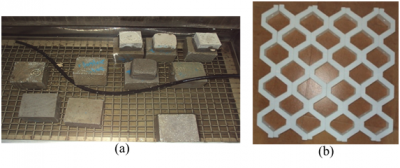
Geomaterial
The geomaterial is prepared by blending fly ash with expanded polystyrene (EPS) beads and a binder such as cement. The effects of different compositions and different mix ratios between EPS beads and fly ash (0.5- 2.5 %), cement and fly ash (10-20 %), and water and fly ash (50 and 60%) on density, compressive strength, and initial tangent modulus of the geomaterial formed are studied. With the inclusion of merely 0.5-2.5% of EPS beads to fly ash (by weight), the density of the geomaterial formed can be reduced from1, 320 to 725 kg/m3 . The compressive strength of EPGM increases considerably if cement-to-fly ash ratios of 10, 15, and 20 % are used. Compared with EPS block geofoam, EPS beads mixed geomaterial has higher density but higher compressive strength and higher stiffness. Thus the geomaterial developed can be used as a substitute for EPS geofoam block when strong fill materials with high strengths are required.
Cellular Reinforcement
The performance of expanded polystyrene (EPS) geofoam based cellular reinforcement with fly ash as filling material overlying a soft clay bed through small-scale laboratory model tests was studied. EPS geofoam cellular reinforcement of densities 15, 20, 22, and 30 kg/m3 were prepared in the form of a mattress with three different heights of 50, 75, and 100 mm. The effects of density of EPS geofoam and height of cellular reinforcement were tested through a series of tests to systematically study the overall performance of the system in terms of load carrying capacity and settlement behaviour. Test results indicated that the provision of EPS geofoam cellular reinforcement in fly ash bed significantly improved load carrying capacity above the clay bed. The load carrying capacity decreased with increasing density of EPS geofoam and increased with increase in height of cellular reinforcement.
Prof. J N Mandal
